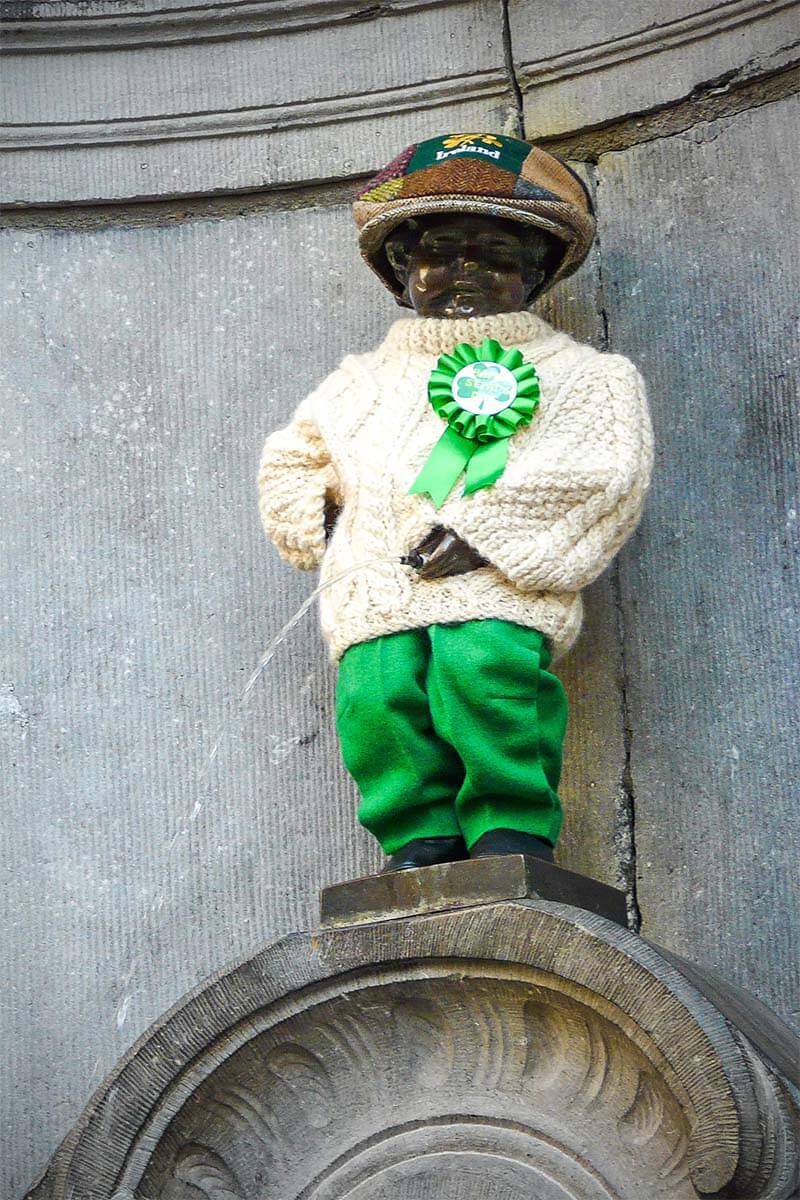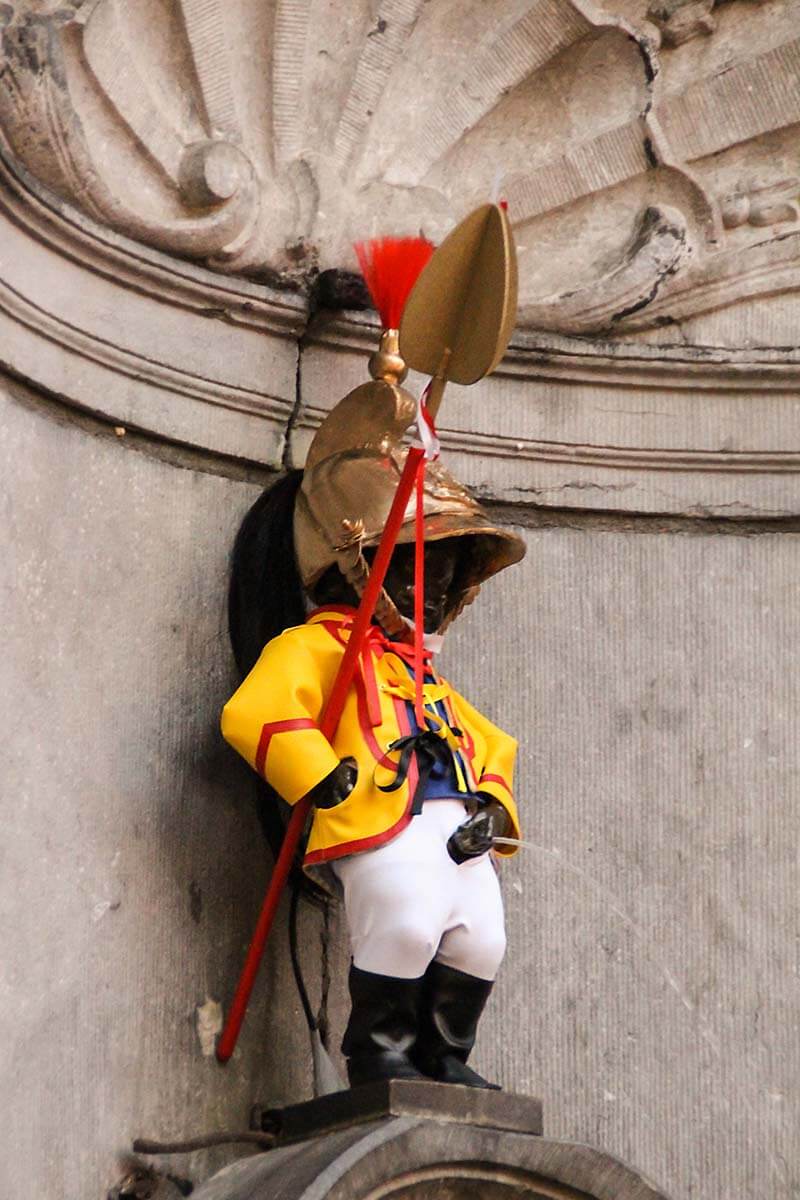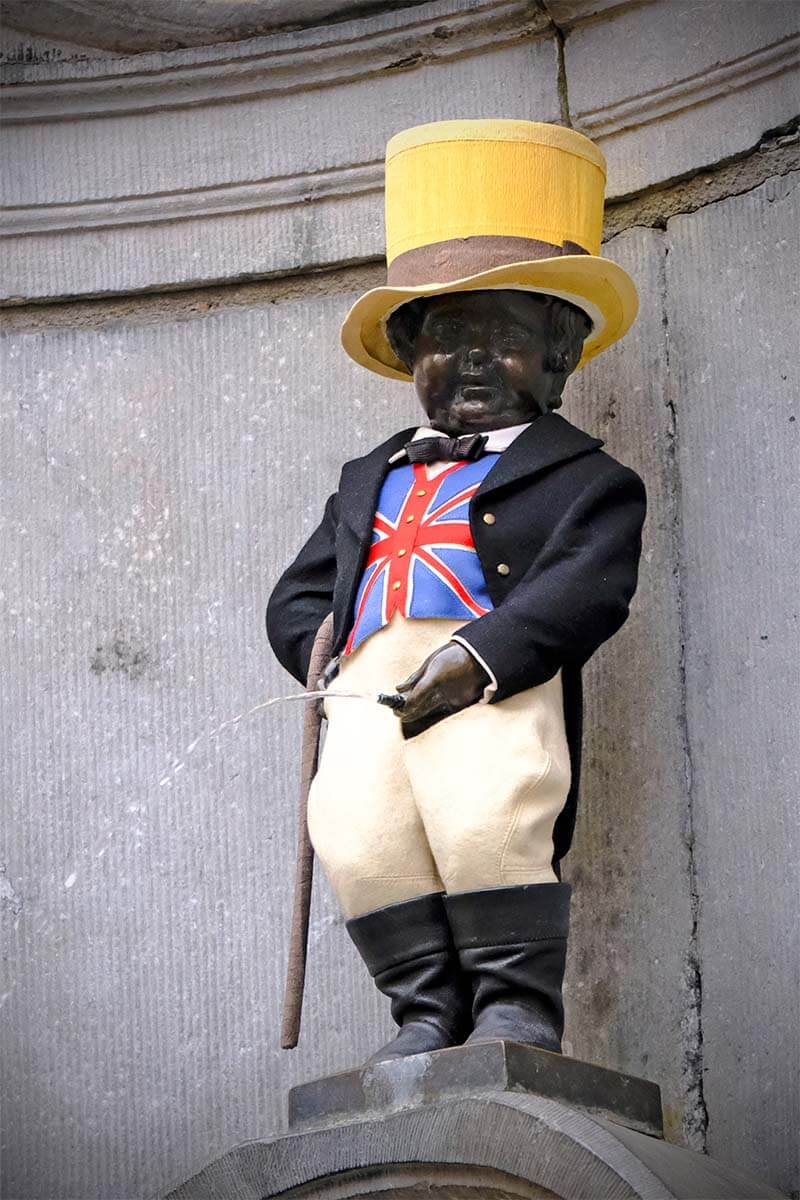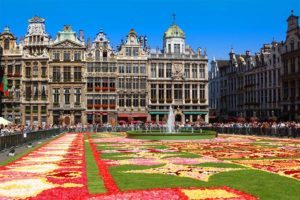Why a Peeing Boy Became the Symbol of Brussels (Manneken Pis Story)

This site contains affiliate links, which means that we may earn a small commission, at no cost to you, for qualifying purchases. It supports the work that goes into keeping this content free. Thanks for reading! More info: Privacy Policy.
You may have heard about Manneken Pis, the peculiar symbol of Brussels, Belgium.
If you are not familiar with it, Manneken-Pis is a bronze statue of a small naked peeing boy. The iconic fountain dates from the 17th century, with its origins going back to the 14th century. It’s one of the most popular places to visit in Brussels.
Indeed, no visit to Brussels would be complete without taking a selfie with its most famous citizen.
But how did this eccentric little fellow earn such a prominent place in the heart of the city?
Having lived in Belgium for over two decades, I learned that there are a couple of interesting legends that surround the origins of Manneken Pis.
While most guides will tell you the first version, there are several others too, some much more plausible than the most popular tale. In fact, the last explanation is the most convincing and – who know – this could be the real story of Manneken Pis.
So let’s delve into a couple of intriguing myths that surround the origins of the little peeing boy and how it became the symbol of Brussels. Find out!
Good to know: While Manneken Pis is normally naked, he also has hundreds of amazing costumes that he wears on different occasions. So in this article, we also included some pictures showcasing a small part of his impressive garderobe.
At the bottom of this post, you will also find some fun facts about Manneken-Pis and his friends (yes, there are more peeing statues in Brussels!).

Here are some of the legends surrounding the origins and fame of Manneken Pis:
Legend # 1: Manneken Pis Saves Brussels from Fire
The version where Manneken Pis saves the city from fire is the most popular legend. There are several slightly different versions of this story. It likely dates from the 14th century when most buildings were built of wood and a tiny spark could destroy an entire town in a matter of hours…
It is said that during a period of siege, the citizens of Brussels put up such fierce resistance that the besiegers finally had to retreat. The defeated enemy, however, was so angry that they decided to burn down the city on the way out. They put gunpowder under the ramparts leading to a large powder barrel. Because the water supply of Brussels was sabotaged by enemies, even a small fire could have been fatal to the city.
In the meantime, the citizens of Brussels were celebrating their victory and didn’t notice the danger. A young boy named Julian (Julien) spotted the threat and urinated on the enemy’s gunpowder, extinguishing the fuse and saving the city of Brussels from destruction.
In honor of his heroic act, a statue was erected depicting him in his moment of glory.

Legend #2: The Lost Boy
According to another enchanting tale, a nobleman lost his son in the busy streets of Brussels. Desperate to find him, the family organized a city-wide search.
After two days of searching, they found the boy urinating on a corner of two streets.
Overjoyed to have found his son, the nobleman decided to immortalize the moment by commissioning the iconic statue of a little peeing boy at that location.

Legend #3: Punished by a Witch
This legend tells a story of a little boy, the son of a nobleman, who abandoned a religious procession because he had to pee. What he didn’t know is that he urinated on the wall of a witch’s house.
The witch was furious and cursed the little boy. To punish him, she turned him into a statue so that he would continue his indecent peeing forever and ever.
This story has two somewhat different endings. In another version, a good man who had seen everything happen, replaced the boy with a statuette right before the witch cast her spell.

Legend #4: Young Duke Supports His Troops
Yet another legend dates to the 12th century. Following the death of his father, a 2-year-old Duke Godfrey III of Leuven became the Count of Brabant. However, the young Duke had enemies who saw this as a great opportunity to take over the region.
The army was deployed but they needed some motivation to know who they were fighting for. So the young boy was taken to the battlefield at Ransbeek, north of Brussels. His cradle was hung in a tree to oversee the troops and motivate them. Of course, the little boy couldn’t sit there for three days without using a bathroom, so he would stand up in his crib and pee down.
One story says that he urinated on the enemies and they lost the battle. Another version says that the troops simply found it an amusing sight.
Either way, after the victory, they moved the oak tree from which the cradle had hung to Brussels and planted it in the city center. The street was named Oak Street – Rue du Chêne (French) or Eikstraat (Dutch). On the corner, right next to the tree, a statue of a peeing boy peeing was erected. That’s where it still stands today.

Legend #5: Tribute to Tanneries
This is now considered the most likely, real story behind Manneken-Pis.
According to this legend, the statue of Manneken Pis was erected as a tribute to the many tanneries that were located in this part of Brussels.
Back in the Middle Ages, the urine of small children used to be used to process the leather. The ammonia in the urine and high Ph help soften the animal leather and make it easier to clean and process it.

Manneken Pis: Interesting Facts
If the statue of the little peeing boy in Brussels got you intrigued, here are some interesting and fun facts about Manneken Pis:
- Most first-time visitors are always amazed at how small the statue of Manneken Pis is. Indeed, it’s tiny – just 55.5 cm (about 21.9 inches).
- For such a little boy, Manneken Pis is surprisingly old. The original bronze statue dates from 1619. In addition, there was a similar wooden statue at the same location in the 14th century already.
- Manneken Pis in Brussels has more than a thousand different costumes. They are kept in several museums in Brussels. The costumes are usually changed every 2-3 times a week and are usually worn for a specific occasion. This could be pretty much anything from a national or international holiday, an anniversary of a local school, or to support Belgian sports teams during various competitions…
- The oldest costume of Manneken-Pis dates from 1747 and was gifted by the French King, Louis XV. French soldiers stole the statue angering the people of Brussels. The King felt ashamed of his troops. To make up for it, he declared Manneken-Pis a knight of the Royal and Military Order of St Louis and gifted him a suitable outfit.
- Manneken Pis has been stolen countless times throughout history. In fact, during one such attempt in 1965, the statue was broken and it took months to find the missing piece back (someone threw it in a canal in Brussels). In the meantime, a new bronze statue had been made. When the original was recovered and glued together, it was placed in Brussels City Museum – Maison du Roi (located at Grand-Place). So if you would like to see the original statue of Manneken-Pis, be sure to visit this museum as well. You will also see some of the Manneken-Pis costumes here.
- The town of Geraardsbergen west of Brussels has a similar statue of a peeing boy. They claim that theirs is the oldest one since it dates from 1459, whereas the bronze statue in Brussels is from 1619. However, there was a similar fountain in Brussels in 1388 already, so there is no doubt that Manneken-Pis is originally from Brussels.
- There are many replicas and copies of Manneken-Pis all over the world – from smaller towns in Belgium or Colmar in France to the biggest metropoles in Japan. Indeed, you can find a similar statue of a peeing boy in Hamamatsucho Station in Tokyo.
- Manneken-Pis has similar friends in Brussels – see more info below (with pictures and a map of where to find them!).

The Friends of Manneken-Pis: Jeanneke Pis & Zinneke
Manneken-Pis is not the only peeing statue in Brussels.
If you are interested, you can also visit his ‘sister’ Jeanneke Pis, and the peeing dog Het Zinneke. They are all located in the city center, so you can easily see them all when visiting Brussels.
Below, you can see the map indicating the location of all these statues.


While the true origins of Manneken Pis remain shrouded in mystery, the statue is an unmistakable symbol of Brussels. It reflects the city’s resilience, unique sense of humor, and ability to not take everything too seriously.
So, the next time you go to see Manneken Pis in Brussels, take a moment to reflect on all these legends and the meaning behind its costumes.
There’s definitely more to this seemingly whimsical statue than it looks at first sight!
YOU MAY ALSO LIKE TO READ: Fun Facts About Belgium
More travel inspiration & info for visiting Belgium:
- Itinerary: Belgium Itinerary for 3-4 Days
- Brussels:
- Bruges:
- Antwerp:
- Winter visit:
If you found this post helpful, don’t forget to bookmark it and share it with your friends. Are you on Pinterest? Pin this image!










Yes I do know about this little guy and he is on my Google Maps list. I did not know about his friends though and I never knew about any of the costumes.🤔
Now you can add the little friends of Manneken-Pis to your map too ;).
Hope you get to visit Belgium one day, Michael!
@Jurga, indeed we will. ✈️👍🙂